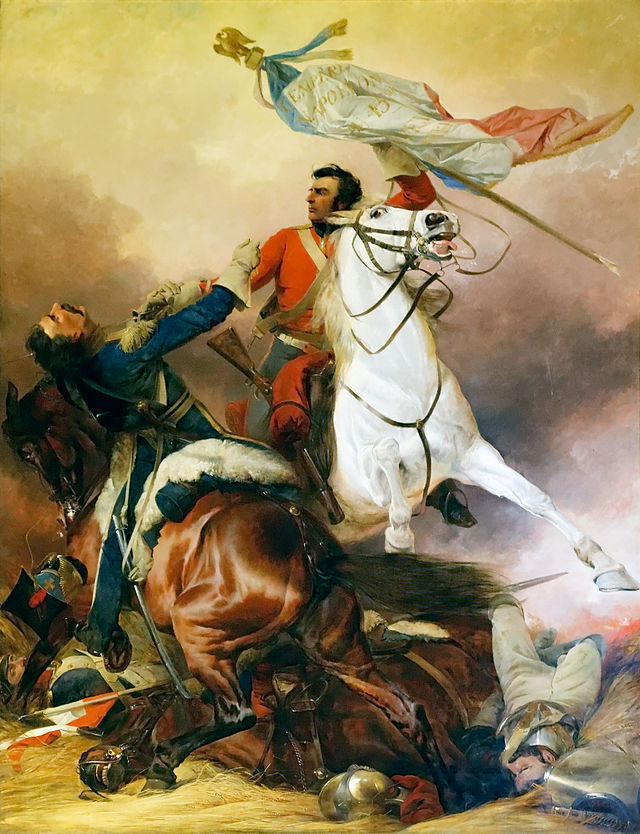This is an excerpt from the Waterloo 200 Descendants Book, visit the book’s website here.
John Cummings is my great-great-great grandfather. It was a surprise to find that he was from the North East of England, his wife from Buckinghamshire, and their daughter, Mary Ann, born in London. I began by researching his daughter, Mary Ann, who was living with my grandparents in Rochdale in the 1911 census. From her marriage certificate I discovered that her father was John Cummings and his occupation ‘army’.
That was about 12 years ago. As more information came online I was able to crosscheck the clues – a fascinating process. As more records became available online I was able to confirm details in the story of John Cummings. I had been side-tracked by the re-marriage of his wife, Sarah. Eventually, I discovered records of the marriage by licence between John Cummings and Sarah Finch at St Martin-in-the-Fields on 1st June 1821.
I still haven’t found out what happened to the family between his discharge from the army in 1834 and his wife’s remarriage in 1847. I suspect that it’s a potentially grim story, given what was happening at the time, but one key feature that seems to crop up throughout all our family stories is the triumph of endeavour over adversity. I do admire them.
I think that Private John Cummings was involved in the defence of Hougoumont in Lieutenant Colonel Canning’s Company, 2nd Battalion, 3rd Regiment of Foot Guards. It was during this action that Lt Col Canning, ADC to Wellington, was killed. He served from 1813-1834, in France, Flanders, at Waterloo, Portugal and home.
I have not visited Waterloo but hope to do so at some point in the future.
Two of John Cummings’s great-grandsons died during World War I. My grandfather, James Barker – who served in the Royal Field Artillery – died in August 1916. His brother, Ernest Barker, King’s Liverpool Regiment, died in December 1916. My father, Thomas Barker, served in the Royal Artillery during World War II. Unlike John Cummings, they were not career soldiers, but it has been interesting to discover how war has affected six generations of our family in various ways.
It has been particularly moving to read physical descriptions of family members from their army service records and to realise how similar their character references are – they were all good men who gave of their best. I am so pleased to be able to record something of their lives for future generations.
The wider story of these men is the story of their families. I have always been conscious of how very lucky we have been to be born post-World War II. Wherever I have researched in our family’s history (to about 1750 in all grandparents) I have found stories of women who have been widowed with very young children.
They all worked hard to achieve the best for their children and were much loved by them. Sarah Cummings and her daughter, Mary Ann, were both young widows. In the 1861 census Mary Ann is a young widow with two sons under the age of two. In the 1911 census she is aged 80 and living with her grandson, James and his wife, Elizabeth, a young married couple. Her grandson was to die five years later during World War I and the pattern was to be repeated. My grandmother was left a young widow with a son not yet three. It is impossible not to feel for them but most of all to admire their indomitable spirit.
Army Service Record – National Archives
John Cummings: Born 1795 in Chester-Le-Street. Scots Fusiliers of Foot Guards Whereof Field Marshall HRH The Duke of Gloucester is Colonel.
Attested for the Third Regiment of Foot Guards in Newcastle in the County of Northumberland on 30 November 1813, at the age of 18 years. 1st Service.
After the age of 18 years, which he is entitled to reckon up to the 20 December 1833, 20 years and 22 days.
Service at Waterloo 2 years. Further service from 21 December 1833 to 7 January 1834 when finally discharged. Total service 22 years 40 days.
Medical letter of discharge from the army
I certify that Private John Cummings is totally unfit for Service, in consequence of Paralysis of the right leg and arm, has been under treatment seven months. This disability has arisen from the effects of the service.
Signed Edwd Salmon, Surgeon Major, Scots Fusiliers Guards. London, 20 Dec 1833.
For more amazing stories from history, check out the new issue 15 of History of War or subscribe now to get 30% off the cover price!
10% off all orders in the ImagineShop for the whole of May



